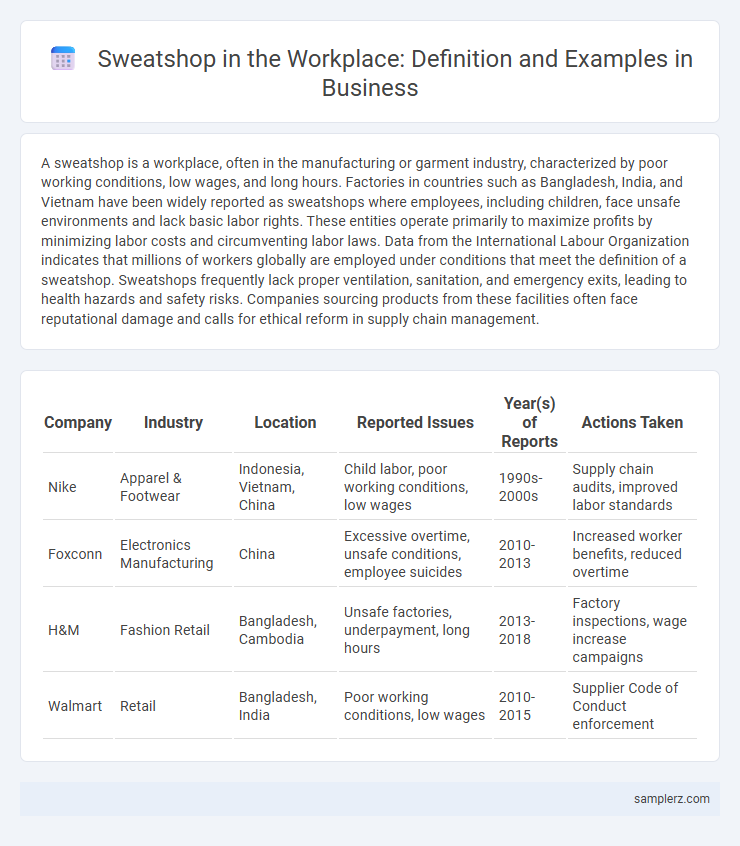A sweatshop is a workplace, often in the manufacturing or garment industry, characterized by poor working conditions, low wages, and long hours. Factories in countries such as Bangladesh, India, and Vietnam have been widely reported as sweatshops where employees, including children, face unsafe environments and lack basic labor rights. These entities operate primarily to maximize profits by minimizing labor costs and circumventing labor laws. Data from the International Labour Organization indicates that millions of workers globally are employed under conditions that meet the definition of a sweatshop. Sweatshops frequently lack proper ventilation, sanitation, and emergency exits, leading to health hazards and safety risks. Companies sourcing products from these facilities often face reputational damage and calls for ethical reform in supply chain management.
Table of Comparison
| Company | Industry | Location | Reported Issues | Year(s) of Reports | Actions Taken |
|---|---|---|---|---|---|
| Nike | Apparel & Footwear | Indonesia, Vietnam, China | Child labor, poor working conditions, low wages | 1990s-2000s | Supply chain audits, improved labor standards |
| Foxconn | Electronics Manufacturing | China | Excessive overtime, unsafe conditions, employee suicides | 2010-2013 | Increased worker benefits, reduced overtime |
| H&M | Fashion Retail | Bangladesh, Cambodia | Unsafe factories, underpayment, long hours | 2013-2018 | Factory inspections, wage increase campaigns |
| Walmart | Retail | Bangladesh, India | Poor working conditions, low wages | 2010-2015 | Supplier Code of Conduct enforcement |
Understanding Sweatshops: Definition and Key Characteristics
Sweatshops are workplaces where employees endure long hours, minimal wages, and unsafe conditions, often violating labor laws and human rights. These environments are characterized by excessive overtime, lack of benefits, and inadequate safety measures, commonly found in garment factories in developing countries. Understanding sweatshops requires recognizing the exploitative labor practices that prioritize profit over worker welfare, leading to systemic abuse within global supply chains.
Historical Overview of Sweatshops in Business
Sweatshops have historically appeared in the textile and garment industries during the Industrial Revolution, with factories employing large numbers of workers under poor conditions for minimal wages. Notorious examples include New York City's Triangle Shirtwaist Factory, where unsafe environments led to tragic accidents and spurred labor reforms. These exploitative workplaces highlight the early challenges of industrial labor rights and the ongoing struggle against unethical business practices.
Notorious Sweatshop Scandals in Modern Companies
Notorious sweatshop scandals in modern companies include the 2012 Foxconn controversy, where workers assembling Apple products endured excessive overtime and unsafe conditions, sparking global outrage. Nike faced similar backlash in the 1990s for exploiting labor in Southeast Asian factories with substandard wages and child labor. These examples highlight ongoing issues of labor violations in multinational supply chains despite corporate social responsibility pledges.
Global Examples of Sweatshops in the Workplace
Global examples of sweatshops in the workplace are prevalent in industries such as garment manufacturing in Bangladesh, electronics assembly in China, and footwear production in Vietnam. These sweatshops often feature exploitative labor practices, including long working hours, low wages, unsafe conditions, and lack of workers' rights. Multinational corporations sourcing from these regions face increasing scrutiny as supply chain transparency becomes a critical issue for ethical business standards.
Sweatshops in the Fashion Industry: High-Profile Cases
Sweatshops in the fashion industry often involve exploitative labor practices, as seen in high-profile cases like the 2013 Rana Plaza collapse in Bangladesh, which exposed unsafe working conditions for garment workers producing for major brands. Companies such as Nike and H&M have faced public backlash for relying on factories with low wages, excessive hours, and insufficient health and safety standards. These cases highlight ongoing challenges in supply chain transparency and ethical labor compliance within global fashion manufacturing.
Tech Industry Sweatshops: Hidden Labor Practices
Tech industry sweatshops often involve outsourced factories where workers endure long hours, low wages, and unsafe conditions to produce electronic devices and components. These hidden labor practices negatively impact employee well-being and violate labor laws while maximizing profit margins for major technology corporations. Exposure of such exploitative factories has led to increased demands for corporate social responsibility and ethical supply chain management.
The Role of Multinational Corporations in Sweatshop Operations
Multinational corporations such as Nike and H&M have been widely criticized for their indirect involvement in sweatshop operations by outsourcing production to factories with poor labor conditions in countries like Bangladesh and Cambodia. These companies often prioritize cost-cutting and fast production cycles, which can lead to exploitative wages, excessive working hours, and unsafe environments for workers. Monitoring and enforcing labor standards remains a challenge due to complex global supply chains and limited regulatory oversight in developing markets.
Legal Implications and International Labor Standards
Sweatshops often violate international labor standards such as the International Labour Organization's (ILO) conventions on fair wages, working hours, and occupational safety. Legal implications include potential lawsuits, hefty fines, and reputational damage, as companies may face penalties under laws like the U.S. Tariff Act or the UK Modern Slavery Act for sourcing from exploitative factories. Compliance with global labor regulations is critical to avoid sanctions and maintain brand integrity in international markets.
Social and Economic Impacts of Sweatshop Environments
Sweatshop environments often exploit workers through low wages, excessive hours, and unsafe conditions, resulting in significant social harm such as poor health and limited social mobility. Economically, these workplaces perpetuate poverty cycles by underpaying labor, reducing consumer purchasing power, and undermining fair market competition. The exploitation within sweatshops also triggers negative global supply chain repercussions, affecting brand reputations and inviting regulatory scrutiny.
Solutions and Corporate Responsibility to Eliminate Sweatshops
To eliminate sweatshops, corporations must implement stringent supply chain audits and enforce fair labor standards globally, ensuring compliance with ethical manufacturing practices. Investing in transparent work environments and partnering with certified fair-trade organizations promote workers' rights and safe working conditions. Sustainable business models incorporating corporate social responsibility initiatives strengthen brand reputation and drive long-term economic and social benefits.

example of sweatshop in workplace Infographic
 samplerz.com
samplerz.com